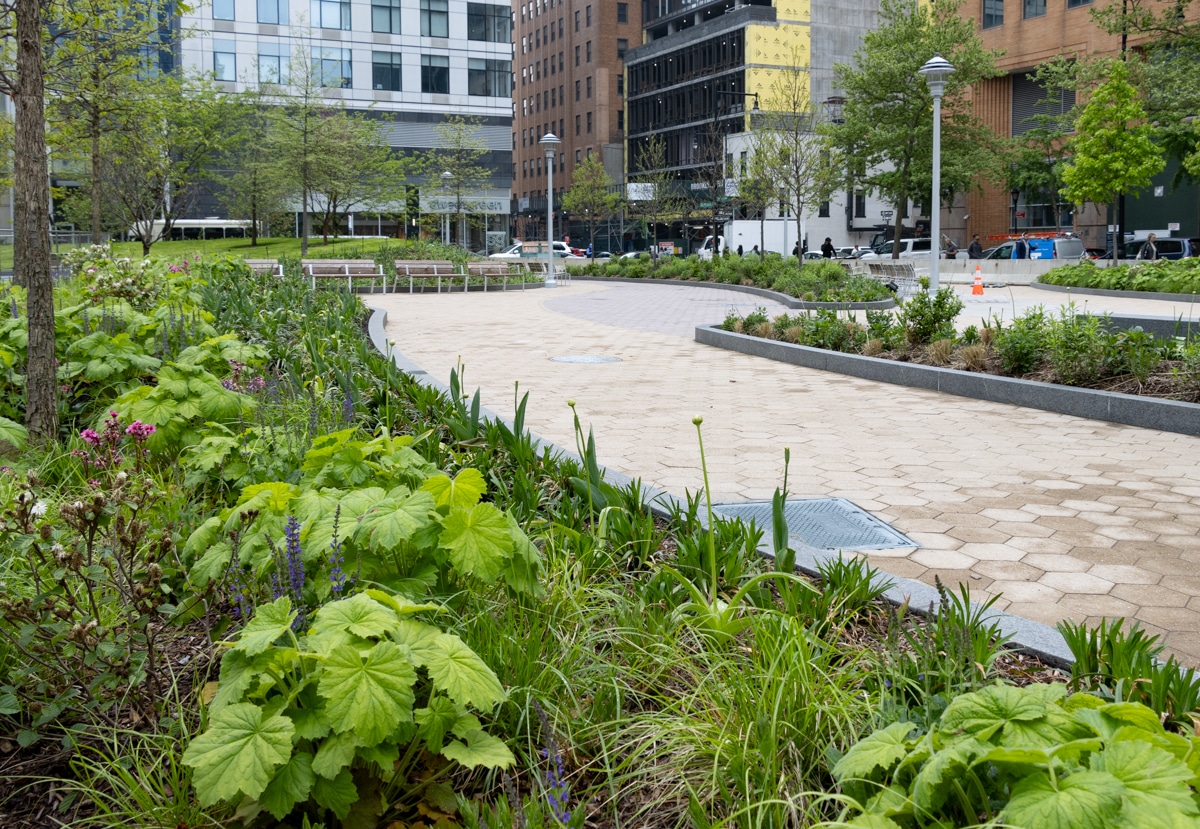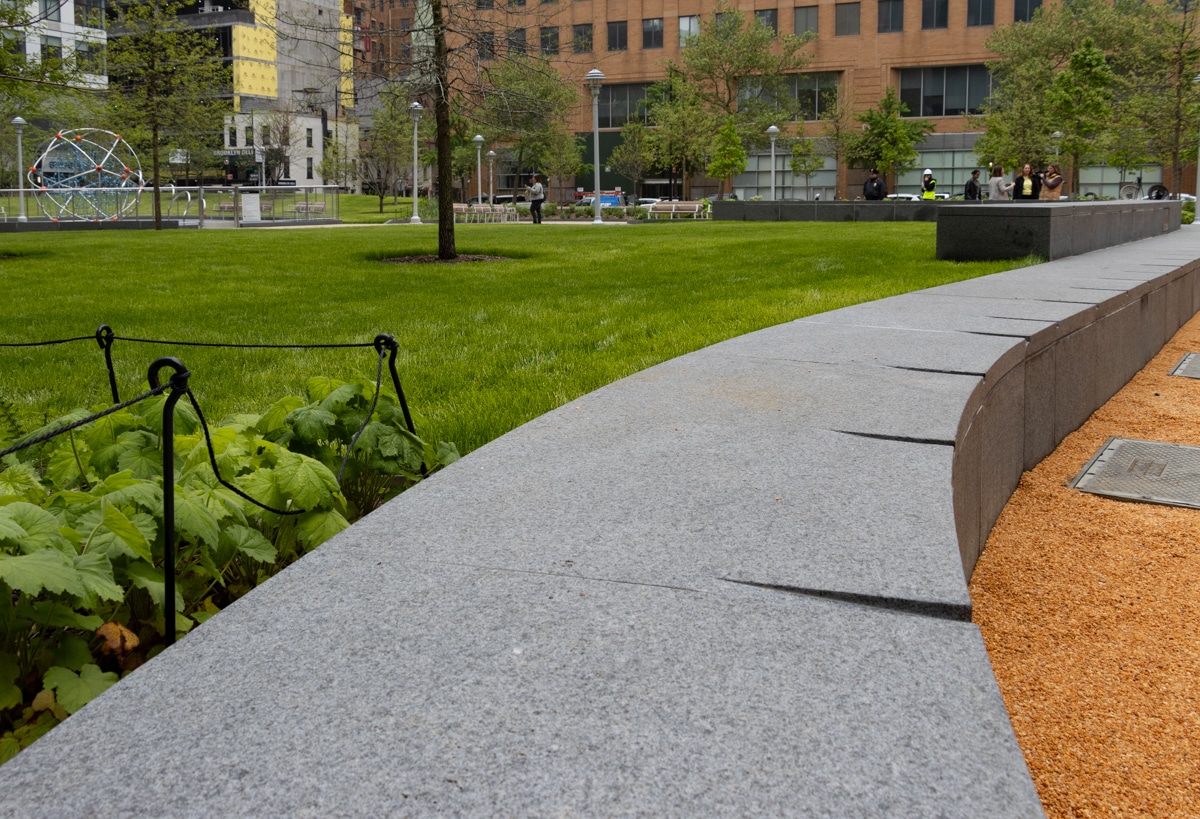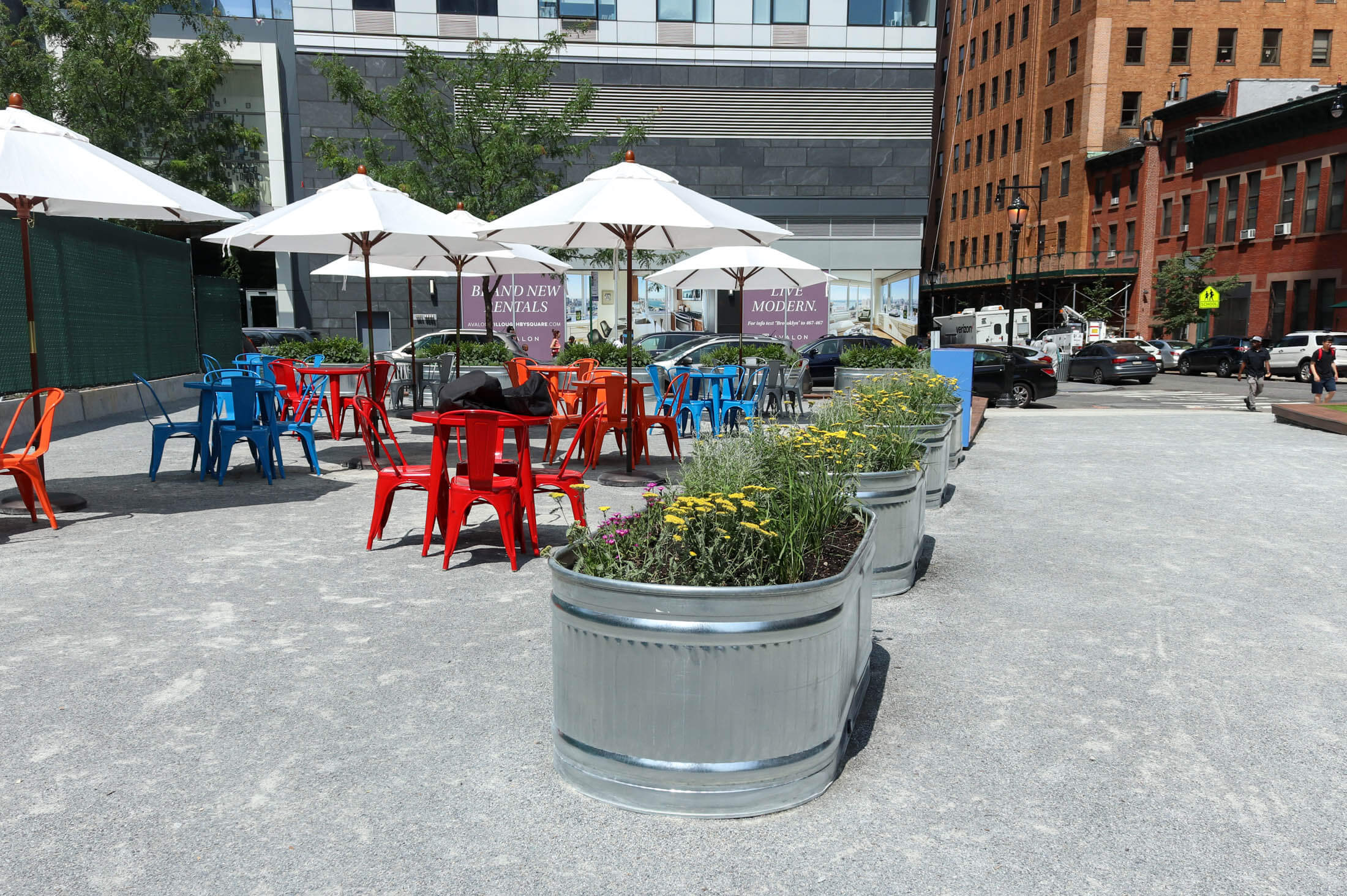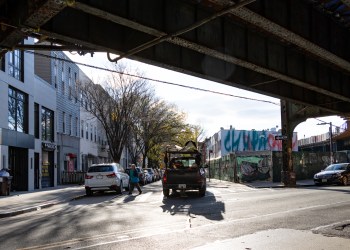Decades in the Making, Abolitionist Place Park Opens to Public
The 1.15-acre park gives Downtown Brooklyn locals a much needed green space in an area that has become heavily developed in recent years.

The park on Monday. Photo by Susan De Vries
Abolitionist Place park, a public park that commemorates Brooklyn’s abolitionist history, is finally open to the public after at least 20 years of planning, multiple controversies, several iterations, and many delays.
The 1.15-acre park at 225 Duffield Street opened today, officials told Brownstoner Monday, with a ribbon cutting ceremony scheduled for Wednesday, giving Downtown Brooklyn locals a much needed green space in an area that has become heavily developed in recent years.
With the tulips already gone, and the allium yet to bloom, the expanse is indeed very green. This morning visitors strolled on the paths and sat on benches, though police shooed people and dogs away from the dog run, playground, and other areas, saying the park would open Wednesday. By early afternoon, the playground was unlocked and packed with kids, and dogs were playing in dog run.



Included in the park, bordered by Albee Square and Willoughby and Duffield streets, are a number of planted areas with a mix of native plants and colorful flowers, an interactive water feature that will be turned on in hot weather, a children’s playground, a central lawn, a paved area with boulders, seating including benches, and a small dog run. The landscape architect for the project is Hargreaves Jones, and the landscaper is Wetlands.
Initially slated to open with the city-owned park, a public art display honoring the area’s abolitionist past will be installed in coming years following a recent change of artist.
Jennifer Cass, SVP of capital programs at the city’s Economic Development Corporation, which has been behind the park’s construction, told Brownstoner it had “been a labor of love to see this turn into a green space for the community and really just open space where the community needs it.”
She said the agency had collaborated with the community throughout the design and construction process, and incorporated local feedback, including the need for a dog run. However, not everyone in the community was happy about its inclusion, and protesters in 2021 demanded more recognition of the area’s abolitionist past.
As well as the dedicated spot for dogs and the children’s playground, Cass said, there is a lot of flexible space included in the park to cater to different activities and users. The mild grade changes throughout are designed to create a rolling meadow-like effect, giving a sense of movement and elevating the planted areas, she said.



Meanwhile, Regina Myer, president of the Downtown Brooklyn Partnership, which will operate the park, said she was thrilled opening day had arrived after many years of the construction fence ringing the site.
“We see this park serving everybody in the neighborhood, certainly children, certainly residents, certainly people who are staying at the hotels, office workers in the buildings, both at Brooklyn Commons, Willoughby Square. It’s really an exciting location for us to have this new open space,” Myer said.
As well as maintaining the park, Downtown Brooklyn Partnership will also manage public programming, starting next Thursday with a story hour, she said. “We’re really looking to build community from the ground up in terms of loving this park,” she said. “This is going to be a park that’s really well used, there’s no doubt in any of our minds.”
She said the park will follow the usual city rules, and will be closed from 1 a.m. through 6 a.m. Dogs and furniture will not be allowed on the lawns, and the park will be patrolled, she said.



Previously named Willoughby Square Park, the project dates back to at least 2004 when the city rezoned Downtown Brooklyn as part of its Downtown Brooklyn Plan. Using eminent domain, the city seized and demolished private houses associated with the 19th century abolitionist movement and Underground Railroad, as well as a group of tenement buildings at 402-406 Albee Square evicting dozens of families who had lived there in rent-regulated apartments for decades, to make way for new privately developed towers and the public park over a high-tech underground parking garage for more than 700 cars.
While skyscrapers quickly rose in the area, the parking garage project stalled multiple times and the park’s future looked murky until the city took over the site in 2019. Dropping the plans for the underground parking lot reduced the project budget from $80 million to $10 million.
In 2021, the park was renamed Abolitionist Place to commemorate the 19th century abolitionist movement in Brooklyn. The EDC pledged to fund a public art installation that honored the area’s history as part of the park’s construction. It was recently announced that Brooklyn-based multimedia artist Kenseth Armstead would take over from artist Kameelah Janan Rasheed after Rasheed and the city “mutually agreed” to part ways on the project, in the words of a rep for the city’s Department of Cultural Affairs.
Rasheed’s proposal for the public art installation was shrouded in controversy from the get-go, with community members accusing the EDC and Public Design Commission of lacking transparency in the artist selection and project approval, and of dismissing local input.



Armstead, who was the runner up to Rasheed in the initial PDC selection process, presented conceptual visualizations of the art installations to Brooklyn’s Community Board 2 in April, whose members unanimously voted to recommend the project to the PDC. His presentation described his two planned installations, titled “True North – Every Negro Is a Star” and “Conductors.” Armstead characterized the works as symbols of freedom for Brooklyn that “work in concert.”
“True North, Every Negro Is a Star” will take the form of a 16-by-33-by-33-foot patina-etched and perforated steel dome, which gives the appearance of stars shining through the steel and guiding the viewer from below. In his presentation to board, Armstead said the goal is to connect the viewer to the “stark facts” of the trans-Atlantic slave trade “with a physical reminder, a point of light, for each of these lives.”
“Conductors” depicts figures in the African diaspora and beyond who helped the formerly enslaved people achieve freedom, including James Newton Gloucester, Willis A. Hodges, Mary Joseph Lyons, and Harriet and Thomas Truesdell. The installation, which was incorporated into the project based on community feedback, will take the shape of embossed, etched, and perforated steel panels with stars and profiles of the figures facing north. “These works allow viewers to engage the abolitionist, face to face, on a human scale,” Armstead said in the presentation.



Nonprofit group Friends of Abolitionist Place, which helped saved neighboring 227 Duffield Street from demolition and is organizing to have it turned into a museum called the Abolitionist Heritage Center to “celebrate Brooklyn’s unique role in American Civil Rights history,” has long advocated for the inclusion of a “Sisters of Freedom” monument to be included in the park.
“I am pleased to say I am really inspired and full of hope after attending a briefing of artist Kenseth Armstead’s proposal for Abolitionist Place park,” Friends of Abolitionist Place co-founder Shawné Lee, who is daughter of the former owner of 227 Duffield Street Joy Chatel, told Brownstoner over email Monday. “He is very transparent regarding his intention and research, and has kept Friends of Abolitionist Place informed and updated. He is very knowledgeable and has shared his studies with the community. Mr. Armstead has without hesitation taken the initiative to listen and obtain key facts and is respectful of the history regarding the Abolitionist movement in Downtown Brooklyn. I look forward to seeing his vision manifest.”
Armstead previously told Brownstoner he was working with local stakeholders, including Friends of Abolitionist Place, about how their visions could be wrapped into his proposal. As well as the community feedback process to take place through the community board, the project will also go before the Public Design Commission for conceptual review, which includes opportunity for public testimony that could influence his design. The public art project will likely take two to three years to complete.
In the meantime, visitors will be able to enjoy the natural beauty on display at the park, which was already being appreciated ahead of the opening on Monday afternoon, with one passerby noting to Brownstoner “the park is amazing.”
Joji Florence, who was walking past with their family, said they didn’t know it was slated to open so soon, and said it was great to have the open space in the densely built up area. “For environmental reasons, mental health, social, emotional reasons, [it’s important] to have these sorts of respites and places to enjoy each other and nature at the same time,” Florence said.


[Photos by Susan De Vries]
Related Stories
- What’s Next for the Landmarked House at 227 Abolitionist Place-Duffield Street?
- Amid Controversy, Artist Starts Public Process for Art at Downtown Brooklyn’s Abolitionist Place Park
- City Takes Over Long-Delayed Willoughby Square Park Project, Plans to Finish by 2022
Email tips@brownstoner.com with further comments, questions or tips. Follow Brownstoner on X and Instagram, and like us on Facebook.









What's Your Take? Leave a Comment